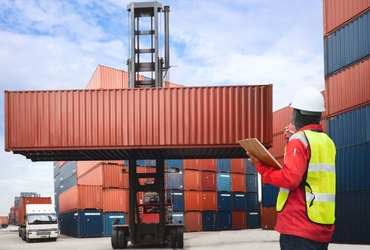
Panama Canal: Six months on



Just a little over six months ago, we witnessed one of 2016’s biggest shipping stories: the inauguration of the Panama Canal expansion. This was, perhaps, also one the most significant moments in ocean freight history.
The expansion created a new traffic lane for larger and deeper ships. It allowed for the tripling in size of vessels that are able to access the waterway of the waterway’s capacity. In this post, we take a look at the canal’s history and its achievements since its historic expansion.
A quick look at the Panama Canal’s history
The Panama Canal is now a 48-mile (77-kilometer) waterway that connects the Atlantic and Pacific Oceans. Its history, however, dates as far back as the 1880s. A French geographical society had thought to build an inter-oceanic canal in Central America. Following its failure, the United States took over the project in the early 1900s. But it wasn’t until January 1914 that the first complete transit by a self-propelled ocean vessel took place. On August 15, 1914, following a $350 million construction, the canal officially opened. It was the costliest construction project in US history at the time. In 1999, reigns of the canal were transferred from the US to Panama.
Today, it’s considered to a key component of the global maritime trade. The American Society of Civil Engineers even recognizes it as one of the seven wonders of the modern world.
Panama Canal inauguration
On June 26, 2016, large crowds attended the first ceremonial pass through the newly expanded canal. Amid waving flags and a cheering crowd, China’s COSCO Shipping’s 9,400TEU Andronikos entered the Agua Clara locks. [Image credit: Reuters]
Panama Canal numbers
Expansion cost: $5.4 billion
Construction began: 3rd September 2007
Inauguration: 26th June 2016
Pre-expansion capacity: 5,000 TEUs
Post-expansion capacity: 14,000 TEUs
Here’s a video of an aerial view of a ship entering the new Panama Canal locks. [Credit: Panama Canal Authority]
According to the Panama Canal Authority, the waterway welcomes at least 13,000 vessels every year. It serves over 144 maritime routes, connecting 160 countries and 1,700 ports. Additionally, it employs around 10,000 workers and operates 24⁄7.
Six months on
Already, in half a year, the canal has received container ships, LPG and LNG vessels, dry bulk carriers and vehicle vessels. Furthermore, the expanded canal has registered over 500 transits since its inauguration. Just last month, the 8,200TEU Yang Ming Unity entered the new locks, becoming the 500th neo-Panamax vessel to transit the expanded canal.
December 2016 also saw the expanded canal receiving its largest vessel since its inauguration - the first 10,500TEU to transit. Hapag-Lloyd’s Valparaiso Express entered the new locks following a number of port calls in South America. It then continued its journey to the Dominican Republic and then Europe. [Image credit: Panama Canal]
As a result of the expansion, the canal recorded its third highest amount of activity in its history. In the fiscal period of October 2015 to September 2016, the Panama Canal handled 330.7 million tons of goods. It also welcomed 13,114 ships, 238 of which were Neopanamax vessels. Take a look at some numbers and figures of the expansion:
![]()
“This latest success reinforces the continued strategic importance of the route and the growing value that recent investments in the canal will bring to the maritime industry.”
– Jorge L. Quijano, Panama Canal Administrator
The container sector remains the strongest source of the canal’s traffic, contributing to over 36% of total cargo. Canal authorities say it will continue to focus on improving its logistics infrastructure in 2017.
The Panama Canal on a global level
Canal authorities say the expansion was needed to maintain the canal’s competitiveness in the global freight industry. The canal has always been an important part of global trade. With its expansion, we’re able to see its impact on the global shipping industry. It’s now easier for freight companies to ship from China to the Eastern Seaboard - the canal’s most lucrative route. Already, at least ten Neopanamax liner services have redirected their routes to the canal.
In the US, various East Coast ports have recorded strong growth due to the arrival of more vessels. This includes the ports of Virginia and Baltimore. Others have started to adapt in order to handle an increase in activity as a result of the expansion. This includes Savannah and Charleston where there are ongoing projects to deepen their channels.
Is the high cost justifiable?
Economists have, however, thrown caution to the wind. Many US ports are still not equipped to handle larger vessels. Plus, the current economic downturn has been nothing but friendly to the freight industry. It’s gobbling up shipping companies, as witnessed in the downfall of Hanjin Shipping. Meanwhile, cooperations such as the Ocean Alliance, THE Alliance and even HMM’s tie-up with Maersk and MSC are becoming a trend.
More recently, emerging reports say that the final construction cost of the canal could potentially triple. The expansion had originally been bid at $3.2 billion. But GUPC, the group that built the expansion, could now claim up to $2 billion in additional cost overruns. According to GUPC, the Panama Canal Authority had given it inaccurate information regarding the area’s geology. That, in turn, led to an underestimation of the project’s complexity. Labor disputes and regulatory problems also resulted in additional delays.
Already, GUPC has won over $215 million in other proceedings. At least six years of litigation is expected before these new claims can be settled. **This means that it may still take a while before we can justify the costly - or perhaps very costly - expansion. **
Related Articles


